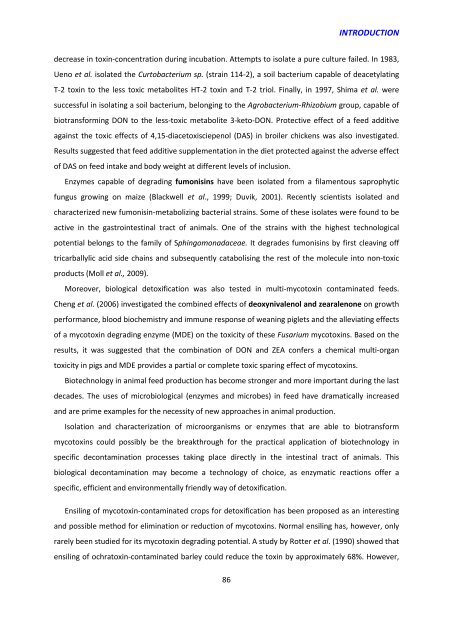Effet chez le porcelet d'une exposition à un régime co-contaminé en ...
Effet chez le porcelet d'une exposition à un régime co-contaminé en ...
Effet chez le porcelet d'une exposition à un régime co-contaminé en ...
You also want an ePaper? Increase the reach of your titles
YUMPU automatically turns print PDFs into web optimized ePapers that Google loves.
INTRODUCTIONdecrease in toxin-<strong>co</strong>nc<strong>en</strong>tration during incubation. Attempts to isolate a pure culture fai<strong>le</strong>d. In 1983,U<strong>en</strong>o et al. isolated the Curtobacterium sp. (strain 114-2), a soil bacterium capab<strong>le</strong> of deacetylatingT-2 toxin to the <strong>le</strong>ss toxic metabolites HT-2 toxin and T-2 triol. Finally, in 1997, Shima et al. weresuccessful in isolating a soil bacterium, belonging to the Agrobacterium-Rhizobium group, capab<strong>le</strong> ofbiotransforming DON to the <strong>le</strong>ss-toxic metabolite 3-keto-DON. Protective effect of a feed additiveagainst the toxic effects of 4,15-diacetoxisciep<strong>en</strong>ol (DAS) in broi<strong>le</strong>r chick<strong>en</strong>s was also investigated.Results suggested that feed additive supp<strong>le</strong>m<strong>en</strong>tation in the diet protected against the adverse effectof DAS on feed intake and body weight at differ<strong>en</strong>t <strong>le</strong>vels of inclusion.Enzymes capab<strong>le</strong> of degrading fumonisins have be<strong>en</strong> isolated from a filam<strong>en</strong>tous saprophyticf<strong>un</strong>gus growing on maize (Blackwell et al., 1999; Duvik, 2001). Rec<strong>en</strong>tly sci<strong>en</strong>tists isolated andcharacterized new fumonisin-metabolizing bacterial strains. Some of these isolates were fo<strong>un</strong>d to beactive in the gastrointestinal tract of animals. One of the strains with the highest technologicalpot<strong>en</strong>tial belongs to the family of Sphingomonadaceae. It degrades fumonisins by first c<strong>le</strong>aving offtricarballylic acid side chains and subsequ<strong>en</strong>tly catabolising the rest of the mo<strong>le</strong>cu<strong>le</strong> into non-toxicproducts (Moll et al., 2009).Moreover, biological detoxification was also tested in multi-my<strong>co</strong>toxin <strong>co</strong>ntaminated feeds.Ch<strong>en</strong>g et al. (2006) investigated the <strong>co</strong>mbined effects of deoxyniva<strong>le</strong>nol and zeara<strong>le</strong>none on growthperformance, blood biochemistry and imm<strong>un</strong>e response of weaning pig<strong>le</strong>ts and the al<strong>le</strong>viating effectsof a my<strong>co</strong>toxin degrading <strong>en</strong>zyme (MDE) on the toxicity of these Fusarium my<strong>co</strong>toxins. Based on theresults, it was suggested that the <strong>co</strong>mbination of DON and ZEA <strong>co</strong>nfers a chemical multi-organtoxicity in pigs and MDE provides a partial or <strong>co</strong>mp<strong>le</strong>te toxic sparing effect of my<strong>co</strong>toxins.Biotechnology in animal feed production has be<strong>co</strong>me stronger and more important during the lastdecades. The uses of microbiological (<strong>en</strong>zymes and microbes) in feed have dramatically increasedand are prime examp<strong>le</strong>s for the necessity of new approaches in animal production.Isolation and characterization of microorganisms or <strong>en</strong>zymes that are ab<strong>le</strong> to biotransformmy<strong>co</strong>toxins <strong>co</strong>uld possibly be the breakthrough for the practical application of biotechnology inspecific de<strong>co</strong>ntamination processes taking place directly in the intestinal tract of animals. Thisbiological de<strong>co</strong>ntamination may be<strong>co</strong>me a technology of choice, as <strong>en</strong>zymatic reactions offer aspecific, effici<strong>en</strong>t and <strong>en</strong>vironm<strong>en</strong>tally fri<strong>en</strong>dly way of detoxification.Ensiling of my<strong>co</strong>toxin-<strong>co</strong>ntaminated crops for detoxification has be<strong>en</strong> proposed as an interestingand possib<strong>le</strong> method for elimination or reduction of my<strong>co</strong>toxins. Normal <strong>en</strong>siling has, however, onlyrarely be<strong>en</strong> studied for its my<strong>co</strong>toxin degrading pot<strong>en</strong>tial. A study by Rotter et al. (1990) showed that<strong>en</strong>siling of ochratoxin-<strong>co</strong>ntaminated bar<strong>le</strong>y <strong>co</strong>uld reduce the toxin by approximately 68%. However,86

















